Simple but challenging: the Universe according to Planck
21 March 2013
ESA's Planck satellite has delivered its first all-sky image of the Cosmic Microwave Background (CMB), bringing with it new challenges about our understanding of the origin and evolution of the cosmos. The image has provided the most precise picture of the early Universe so far.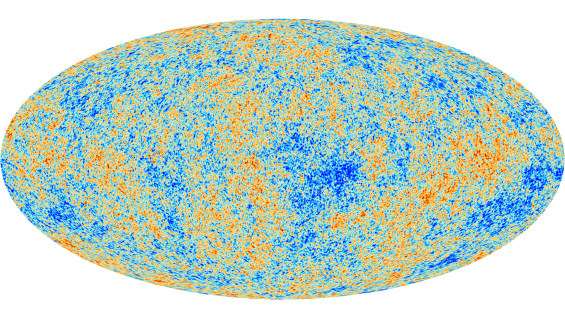 |
|
The Cosmic Microwave Background - as seen by Planck. Credit: ESA and the Planck Collaboration |
For the most part, the data agree extremely well with the 'standard model of cosmology' and allow for a much improved measure of its parameters. In the standard model, the Universe is described as homogeneous and isotropic on very large scales, and cosmic structure is the result of the slow growth of tiny density fluctuations that arose immediately after the Big Bang. At the same time, the extraordinary quality of the Planck data reveals the presence of subtle anomalies in the CMB pattern that might challenge the very foundations of cosmology. The most serious anomaly is a deficit in the signal at large angular scales on the sky, which is about ten per cent weaker than the standard model would like it to be. Other anomalous traits that had been hinted at in the past - a significant discrepancy of the CMB signal as observed in the two opposite hemispheres of the sky and an abnormally large 'cold spot' - are confirmed with high confidence. Planck's new image of the CMB suggests that some aspects of the standard model of cosmology may need a rethink, raising the possibility that the fabric of the cosmos, on the largest scales of the observable Universe, might be more complex than we think.
Cosmologists using ESA's Planck satellite have compiled the most accurate image so far of the Cosmic Microwave Background (CMB), the most ancient light observed in the history of the Universe, emitted only 380,000 years after the Big Bang. By exposing minute differences in the CMB temperature over the entire sky to unprecedented detail, the new Planck image provides a unique snapshot of the slightly mottled Universe as it was when the CMB was released. The pattern of fluctuations observed in the CMB carries a record of the cosmic seeds that were produced immediately after the Big Bang, and that would later evolve into all the structure observed in the Universe today – from stars and planets to galaxies and galaxy clusters.
"The CMB is a portrait of the young Universe, and the picture delivered by Planck is so precise that we can use it to scrutinise in painstaking detail all possible models for the origin and evolution of the cosmos," comments Jan Tauber, Planck Project Scientist at ESA. "After this close examination, the standard model of cosmology is still standing tall, but at the same time evidence of anomalous features in the CMB is more serious than previously thought, suggesting that something fundamental may be missing from the standard framework," he adds.
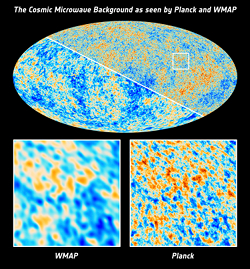 |
|
The Cosmic Microwave Background - as seen by Planck and WMAP. Credit: ESA and the Planck Collaboration; NASA / WMAP Science Team |
In the standard model of cosmology, currently the most widely accepted scenario, the Universe was born almost 14 billion years ago. At this time, its texture was highly homogeneous and isotropic, meaning that its properties were almost exactly the same in every point and that there were no preferential directions in space. This extremely uniform background was punctuated only by minuscule, random fluctuations, which would later give rise to cosmic structure. In spite of the rich variety of structure that currently populates it, the Universe has remained remarkably homogeneous and isotropic on very large scales. But the new CMB image delivered by Planck suggests that some aspects of this model might need revision: in particular, the large-scale isotropy might not hold when considering really large scales.
The standard model of cosmology relies on a multitude of different astronomical observations, from earlier-generation CMB experiments to gigantic surveys of galaxies and the observation of distant supernovae. These data sets, based on entirely different astrophysical sources, agree extremely well with the standard model's two pillar assumptions of homogeneity and isotropy. To reconcile data and theory, however, cosmologists in the past few decades have added some additional, more exotic ingredients that are now an integral part of the standard model: cosmic inflation, an early period of accelerated expansion that marked the beginning of the Universe's history, and during which the seeds of cosmic structure were embedded; dark matter, an invisible matter component whose web-like distribution on large scales constitutes the scaffold where galaxies and other cosmic structure formed; dark energy, a mysterious component that permeates the Universe and is driving its currently accelerated expansion.
"The CMB temperature fluctuations detected by Planck confirm once more that the relatively simple picture provided by the standard model is an amazingly good description of the Universe," explains George Efstathiou of the University of Cambridge, UK.
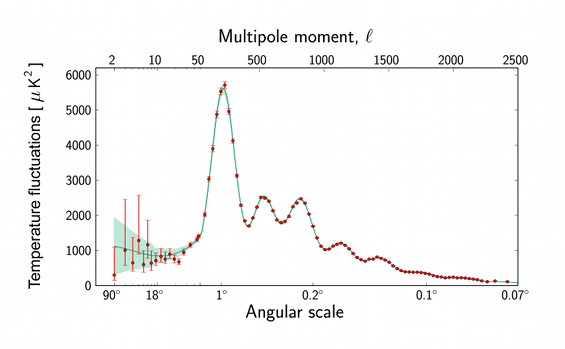 |
|
Planck's power spectrum of temperature fluctuations in the Cosmic Microwave Background. Credit: ESA and the Planck Collaboration |
Cosmologists in the Planck Collaboration have reached this conclusion after painstaking work on the data collected by the satellite over 15.5 months. First, they had to remove all possible contamination due to emission by foreground sources – other galaxies as well as interstellar material in our own Galaxy, the Milky Way – before they could fully explore the CMB data and compare them to cosmological models.
|
Revealing the Cosmic Microwave Background with Planck. Credit: ESA and the Planck Collaboration (Click here for further details about this animation.) |
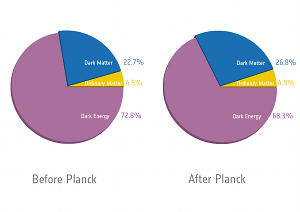 |
|
The new cosmic recipe from Planck. Credit: ESA and the Planck Collaboration |
"By analysing these extraordinary data collected by Planck, we have been able to set the most precise constraints so far on the small number of parameters that we need to characterise the standard model, ranging from the density of dark matter and dark energy to the speed at which the Universe is currently expanding and the relative amount of primordial fluctuations – the seeds of cosmic structures to be – on different scales," adds Efstathiou.
In particular, Planck has provided the first indisputable evidence that the distribution of primordial fluctuations was not the same at all scales, but comprised more structure on large rather than small scales.
"Since these fluctuations were generated during cosmic inflation, this constraint allows us to test the validity of many models that describe the dynamics of this epoch of accelerated expansion of the Universe," says François Bouchet of the Institut d’Astrophysique de Paris, France.
"However, when we try and make sense of the data on the grandest scale, more than about six degrees across the sky, we realise that we might be in trouble," he adds.
|
Planck's anomalous sky. Credit: ESA and the Planck Collaboration (Click here for further details about this animation.) |
The view of the Universe presented in the standard model may not be able to fully explain the richness of detail present in the CMB at the largest scales on the sky, as cosmologists revealed a number of 'anomalies' in the all-sky CMB map that do not fit very well with this model's predictions. While the observations on small and intermediate angular scales agree extremely well with the model predictions, the fluctuations detected on large angular scales on the sky – between 90 and six degrees – are about 10 per cent weaker than the best fit of the standard model to Planck data would like them to be. Another, perhaps related, anomalous signal appears as a substantial asymmetry in the CMB signal observed in the two opposite hemispheres of the sky: one of the two hemispheres appears to have a significantly stronger signal on average. An additional peculiar element in the data is the presence of a so-called 'cold spot': one of the low-temperature spots in the CMB extends over a patch of the sky that is much larger than expected.
The lack of power at large angular scale is convincingly revealed by Planck for the first time, but the hemispheric asymmetry and the cold spot had already been found in the data of Planck's predecessor, NASA's Wilkinson Microwave Anisotropy Probe (WMAP). However, there were lingering doubts about their cosmic origin. With WMAP, in fact, it was not possible to confirm that the anomalies were genuine features in the CMB, rather than the imprint of either data processing or foreground emissions. The fact that these anomalies are also present in the more precise Planck data clears up any doubt about their cosmic origin.
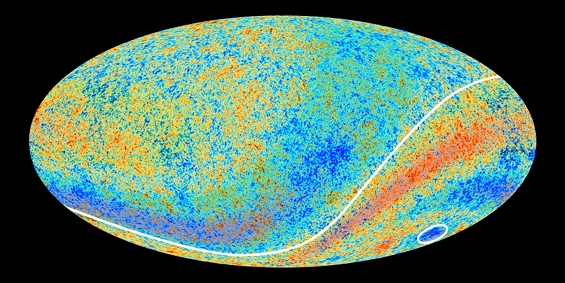 |
|
Planck’s anomalous sky: the hemispheric asymmetry and the cold spot. Credit: ESA and the Planck Collaboration |
"The Planck data call our attention to these anomalies, which are now more important than ever: with data of such quality, we can no longer neglect them as mere artefacts and we must search for an explanation," comments Paolo Natoli from the University of Ferrara, Italy.
"The anomalies indicate that something might be missing from our current understanding of the Universe. We need to find a model where these peculiar traits are no longer anomalies but features predicted by the model itself," he adds.
One of the possible ways to explain the anomalies present in the large-scale pattern of the CMB invites cosmologists to reexamine one of the pillar assumptions of the standard model – isotropy. An existing theoretical framework that describes such a Universe is known as Bianchi models. If the fabric of the cosmos is not isotropic on scales so large that extend beyond the horizon of the 'patch' of the Universe that we can access with observations, its global geometry would be rather complex: this could force bundles of light rays into highly intricate paths where they would be significantly focussed. As CMB photons have travelled across the Universe for most of its history, they might have experienced this effect, resulting in the anomalous pattern of the CMB observed across the sky.
"When we take into account the large-scale anisotropy described by the Bianchi models in the analysis of the Planck data, several anomalies are simultaneously reduced by a significant amount," explains Krzysztof M. Górski from the Jet Propulsion Laboratory (JPL), Caltech, U.S.A.
"However, it is not possible to merge this very specific anisotropic scenario with the standard model that holds very well on 'local' scales. Therefore, this exercise remains a tantalising demonstration of how attempts to reach a satisfactory description of the Universe at large scales might require us to get more creative in developing plausible extensions of the standard model," he adds.
Cosmologists are now facing an interesting dilemma: on the one hand, the standard model of cosmology is still the best way to describe the CMB data, although it includes elements that still lack solid theoretical understanding such as dark matter, dark energy, and inflation. On the other hand, the anomalies seen by Planck highlight that the model should be at the very least extended, if not radically modified.
"The precise measurements of CMB temperature fluctuations achieved by Planck hint at the presence of gaps in the foundations of our understanding of cosmology," comments Tauber. "The Universe seems to be simpler, but at the same time, also weirder than we ever thought. The anomalies in the CMB are telling us something fundamental: we do not know yet what this is, but we are eager to find out," he concludes.
Notes for editors
The new data from Planck are based on the first 15.5 months of its all-sky surveys. Launched in 2009, Planck was designed to map the sky in nine frequencies using two state-of-the-art instruments: the Low Frequency Instrument (LFI), which includes the frequency bands 30-70 GHz, and the High Frequency Instrument (HFI), which includes the frequency bands 100-857 GHz. HFI completed its survey in January 2012, while LFI continues to operate.
Planck's first all-sky image was released in 2010 and the first scientific data were released in 2011. Since then, scientists have been extracting the foreground emissions that lie between us and the Universe's first light to reveal the CMB presented in this release. The next set of cosmology data will be released in early 2014.
The Planck Scientific Collaboration consists of all the scientists who have contributed to the development of the Planck mission, and who participate in the scientific exploitation of the Planck data during the proprietary period. These scientists are members of one or more of four consortia: the LFI Consortium, the HFI Consortium, the DK-Planck Consortium, and ESA's Planck Science Office. The two European-led Planck Data Processing Centres are located in Paris, France and Trieste, Italy.
The LFI consortium is led by N. Mandolesi, Agenzia Spaziale Italiana, Italy (deputy PI: M. Bersanelli, Università degli Studi di Milano, Italy), and was responsible for the development and operation of the LFI instrument. The HFI consortium is lead by J.L. Puget, Institut d’Astrophysique Spatiale in Orsay, France (deputy PI: F. Bouchet, Institut d'Astrophysique de Paris, France), and was responsible for the development and operation of the HFI instrument. The Institut d’Astrophysique Spatiale in Orsay is a Unité Mixte de Recherche (UMR8617) of the CNRS (Centre National de la Recherche Scientifique) and the Université Paris-Sud 11. The Institut d’Astrophysique de Paris is a Unité Mixte de Recherche (UMR 7095) of the CNRS and the Université Pierre et Marie Curie of Paris.
The development of the Planck mission was supported by substantial financial and technological contributions of ESA Member States. More than 40% of the mission's development cost was provided by the agencies supplying HFI and LFI. France and Italy, through the two leading funding agencies CNES and ASI, and the national research bodies, provided more than half of the national funding. The contribution of ESA Member States is even more significant for the scientific operation of the mission and the processing of its data. ESA Member States also provided key technologies such as the innovative cooler that enabled the mission’s instrumentation to be maintained at just one-tenth of a degree above absolute zero (-273.15°C). Important technologies and payload elements were also contributed by NASA.
A series of scientific papers describing the new results have been submitted to the journal Astronomy and Astrophysics. The preprints can be accessed here.
Background information to the topics discussed in this release – the Cosmic Microwave Background and the history of structure formation in the Universe – is available here.
The new data from Planck and the cosmological results based on them have been presented at a media briefing organised by the European Space Agency at Headquarters in Paris, on 21 March 2013, 10:00-12:00 CET. A reply of the briefing is available here. Further results were discussed at a science briefing on 21 March 2013, 14:00-15:45 CET.
The 47th ESLAB Symposium, "The Universe as seen by Planck" is an international conference dedicated to an in-depth look at the results from the Planck mission, and will be held from 2 to 5 April 2013 at ESA/ESTEC in Noordwijk, The Netherlands. More information at: http://www.congrexprojects.com/13a11
Contacts
Jan Tauber
ESA Planck Project Scientist
Research and Scientific Support Department
Directorate of Science and Robotic Exploration
ESA, The Netherlands
Email: jan.tauber![]() esa.int
esa.int
Phone: +31-71-565-5342
George Efstathiou
University of Cambridge, UK
Email: gpe![]() ast.cam.ac.uk
ast.cam.ac.uk
Phone: +44 1223-337530
François R. Bouchet
Institut d’Astrophysique de Paris, France
Email: bouchet![]() iap.fr
iap.fr
Phone: +33-1-44-32-80-95
Paolo Natoli
University of Ferrara, Italy
Email: Paolo.Natoli![]() unife.it
unife.it
Phone: +39-0532-97-42-44; +39-339-80-52-386 (mobile)
Krzysztof M. Górski
Jet Propulsion Laboratory/Caltech
Pasadena, California, USA
Email: krzysztof.m.gorski![]() jpl.nasa.gov
jpl.nasa.gov
Phone: +1-818-648-9670











